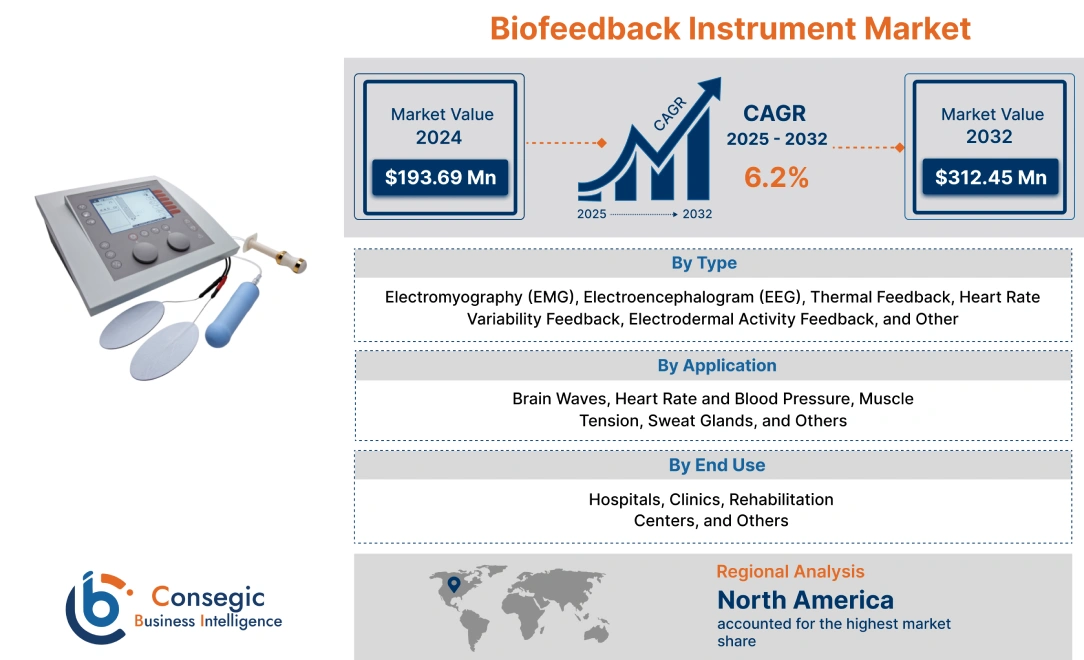Biofeedback Instrument Market Size :
Consegic Business Intelligence analyzes that the Biofeedback Instrument Market size is estimated to reach over USD 312.45 Million by 2032 from a value of USD 193.69 Million in 2024 and is projected to grow by USD 202.17 Million in 2025, growing at a CAGR of 6.20% from 2025 to 2032.
Biofeedback Instrument Market Scope & Overview :
Biofeedback instrument is a device that measures and provides feedback on a patient's physiological functions, such as heart rate, blood pressure, muscle tension, and skin temperature. It is designed to help individuals gain awareness and control over specific bodily functions that are typically involuntary or unconscious. Different types of instruments are designed to measure a different physiological function such as Electromyography (EMG), Electroencephalogram (EEG), Thermal Feedback, Heart Rate Variability Feedback, and Electrodermal Activity Feedback, among Others. It is also used to evauate the effectiveness of theraphy methods in real time and can also be utilitsed to monitior the current progress of the methods. It is used by a biofeedback technician to record stats about the body and then advice about mental and physical exercises to be carried out to gain control of bodily functions.
Biofeedback Instrument Market Insights :
Biofeedback Instrument Market Dynamics - (DRO) :
Key Drivers :
Increasing technological advancement.
Technological advancements have made biofeedback instruments more portable, affordable, and user-friendly. These advancements include wireless connectivity, smartphone applications, wearable devices, and improved accuracy of measurements making biofeedback more accessible and convenient for users.
For instance, in 2018, NeuroSky, a leading provider of biofeedback technology released the Mindwave Mobile 2 Handset is a portable ECG (electroencephalogram) device that measures brainwave activities and provides real-time feedback. This device is designed for applications such as meditation, stress management, and cognitive training. Analysis of market trends concludes that the advancement and product launches by manufacturing companies is driving the biofeedback instrument market demand.
The rising focus on stress management and mental health is likely to accelerate the market growth
Biofeedback instruments are used to help people to manage their stress and improve mental health. Analysis of market trends concludes that the increasing stress and mental health disorders among people have boosted the demand for these instruments. They provide individuals with real-time feedback on physiological responses, helping them better understand and manage stress, anxiety, and related conditions.
For instance, in March 2022, the global prevalence of anxiety and depression increased by a massive 25%, according to a scientific brief released by the World Health Organization (WHO). Further, many people have sought support online, signaling an urgent need to make reliable and effective digital tools available and easily accessible. However, increasing stress and mental health issues are increasing the use of these instruments, which in turn drives the biofeedback instrument market demand.
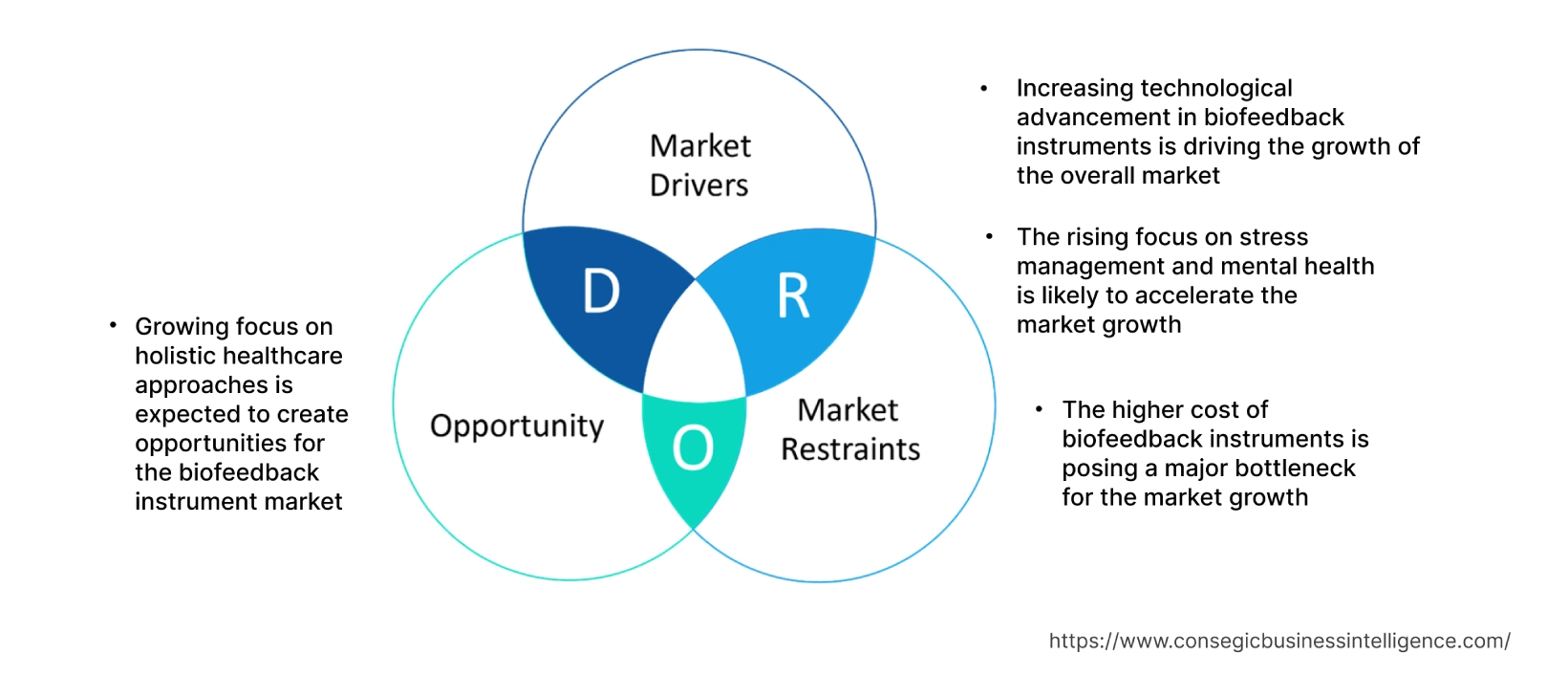
Key Restraints :
The higher cost of biofeedback instruments is posing a major bottleneck for the market growth
The cost of the biofeedback instrument can be a barrier to adoption, especially for those regions that have limited healthcare resources. Analysis of market trends concludes that the high cost associated with these instruments can limit their accessibility, particularly in developing economies.
For instance, According to the University of California, San Diego Medical Center typical fees for visiting a biofeedback therapist is USD 35- USD 85 per session, depending in part on the therapist's experience.
Furthermore, compliance with regulations, testing costs, and other factors are inducing instrument manufacturers to increase their product prices. In addition, other factors such as higher maintenance costs, and sophisticated manufacturing processes impact the overall cost of these instrument at the global level which, in turn, is restraining biofeedback instrument market growth.
Future Opportunities :
Growing focus on holistic healthcare approaches is expected to create opportunities.
Biofeedback instruments can be used in conjunction with holistic healthcare approaches in the healthcare industry to improve overall health and well-being. Holistic healthcare is an approach to medicine that emphasizes the whole person, including their physical, mental, and emotional health. As a result, there is an opportunity for these instruments to be integrated into various healthcare settings, including hospitals, clinics, and wellness facilities. Analysis of market trends concludes that growing focus on holistic healthcare approaches is expected to significantly boost the biofeedback instrument market growth.
Furthermore, The companies dealing in the instrument production are substantially investing in the technological innovations of these instruments. Thus, the launch of new products with upgraded technology will emerging as one of many biofeedback instrument market opportunities that drive market expansion in the forecast years.
Biofeedback Instrument Market Report Insights :
| Report Attributes | Report Details |
| Study Timeline | 2019-2032 |
| Market Size in 2032 | USD 312.45 Million |
| CAGR (2025-2032) | 6.2% |
| Based on the Type | Electromyography (EMG), Electroencephalogram (EEG), Thermal Feedback, Heart Rate Variability Feedback, Electrodermal Activity Feedback, and Other |
| Based on the Application | Brain Waves, Heart Rate and Blood Pressure, Muscle Tension, Sweat Glands, and Others |
| Based on the End-Use | Hospitals, Clinics, Rehabilitation Centers, and Others |
| Based on the Region | North America, Europe, Asia-Pacific, Latin America, and Middle East & Africa |
| Key Players | Thought Technology Ltd, Laborie Qxsubspace, Mind Media USA Inc., Quantum World Vision, Bio Feedback Resources International, NeuroCare, and Neurocare Group AG |
Global Biofeedback Instrument Market Segmental Analysis
By Type :
The product type segment is categorized into electromyography (EMG), electroencephalogram (EEG), thermal feedback, heart rate variability feedback, electrodermal activity feedback, and others. In 2024, the electromyography (EMG) segment accounted for the highest biofeedback instrument market share and is expected to be the fastest-growing segment during the forecast period. Electromyography (EMG) involves the measurement and feedback of electrical activity produced by muscles. It is commonly used in rehabilitation, sports training, and stress management. Assessment of market trends suggest that Electromyography (EMG) feedback helps individuals improve muscle control, reduce muscle tension, and enhance overall physical instruments is significant, especially in the fields of physical therapy, sports medicine, and performance training.
For instance, in 2020, MyoTrac Infinity by Thought Technology Ltd developed an EMG biofeedback device that offers comprehensive muscle activity monitoring and training capabilities. The system includes various sensors and electrodes for measuring muscle tension and providing real-time feedback to users. The biofeedback instrument market analysis concluded that the development of a new product ranges and others are prime factors accelerating the proliferation of the electromyography (EMG) segment.
By Application :
The application segment is categorized into brain waves, heart rate and blood pressure, muscle tension, sweat glands, and others. In 2024, the brain waves segment accounted for the highest biofeedback instrument market share and is expected to be the fastest-growing segment during the forecast period. A electroencephalograph (EEG) is used along with scalp pads for monitoring brain waves using these instruments. Instruments used to deliver biofeedback based on brain waves can be used to treat conditions like obsessive-compulsive disorder (OCD) and Post-traumatic stress disorder (PTSD). Brain waves focus on measuring and providing feedback on the electrical activity of the brain and it is widely used in mental health, neuro therapy, meditation training, and cognitive enhancement. A technician or computer program analyses the brain waves and give feedback based on the state of the brain.
For instance, in 2020, according to the World Health Organization (WHO), globally, more than 264 million people suffer from depression, and around 284 million people have an anxiety disorder. The biofeedback instrument market analysis indicated that the demand for these instruments is propelled by a wide range of organizations and individuals seeking to optimize brain function, improve meant health, enhance performance, and promote well-being.
By End-Use :
The end-use type segment is categorized into hospitals, clinics, rehabilitation centers, and others. In 2024, the hospital segment accounted for the highest market share of 48.15% in the market. Assessment of market trends suggest that use of these instrument in hospitals is influenced by several factors including government initiatives promoting integrative and holistic approaches to healthcare, increasing patient awareness, and demand for non-pharmacological intervention supporting the efficacy of biofeedback in various medical applications. The instruments allow for precise and accurate diagnosis of medical conditions, resulting in efficient treatment of patients. The instruments enable continuous monitoring of patient vitals, thus allowing for timely intervention by medical personnel in case of a medical emergency. Moreover, the integration of these instruments streamlines the workflow of doctors and helps them in recording accurate patient vitals. This ultimately leads to optimization of time required for patient treatment, therefore use of these instrumets allows the doctor to monitor and treat multiple patients at a single time.
However, rehabilitation centre segment is expected to be the fastest-growing segment in the biofeedback instrument market during the forecast period. The instruments could be used for multiple applications like assisting patients in regaining regular movement patterns after an accidental injury. Examination of market trends conclude that the instrumets when used in rehabilitation centre give live real time biological information that ultimately help doctors to visualize breathing patterns and muscle tension patterns. The instrumets utilized for rehabilitation can help in providing relief in various conditions like chronic pains and migrains in patients. The increasing utilization of the instrument can also be attributed to government initiatives, developing guidelines, and spending on research to promote the use of these instruments in rehabilitation centre.
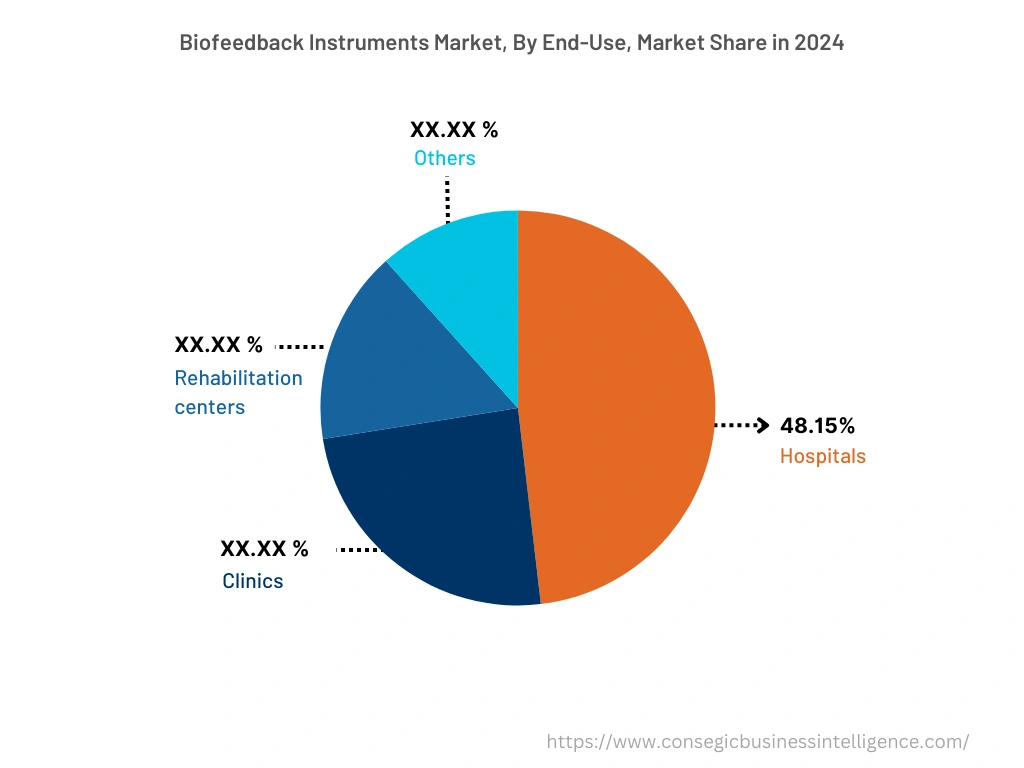
By Region :
The regional segment includes North America, Europe, Asia Pacific, the Middle East and Africa, and Latin America.
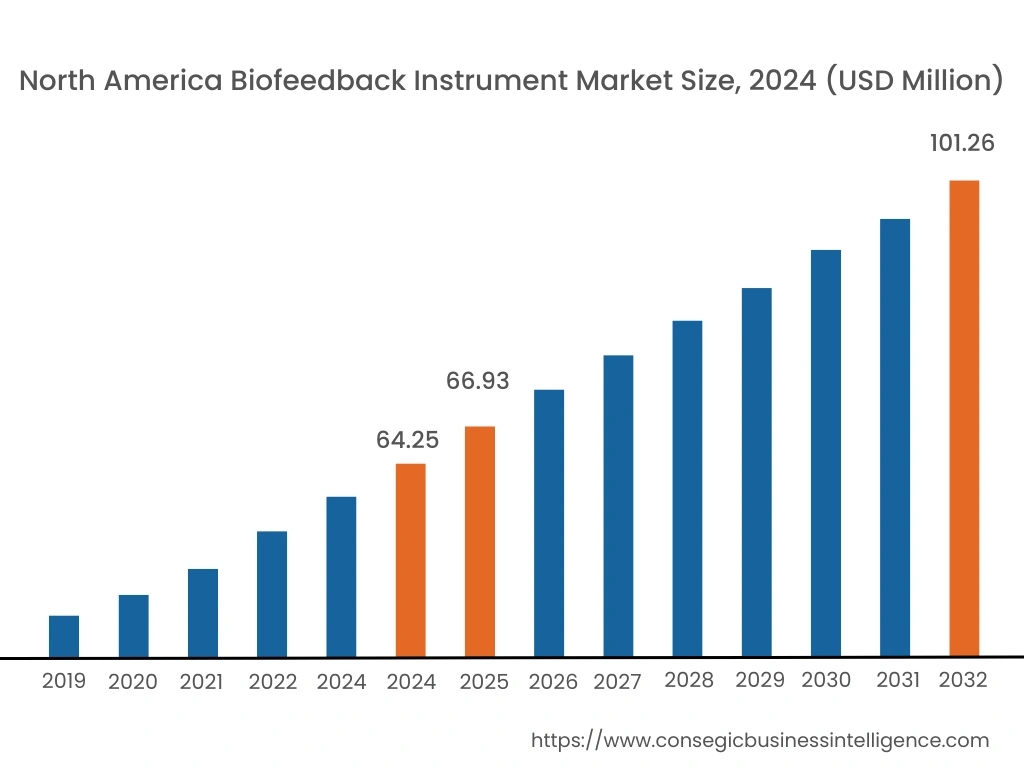
North America accounted for the highest market share at 38.50% and is estimated to reach over USD 101.26 Million by 2032 from a value of USD 64.25 Million in 2024 and is projected to grow by USD 66.93 Million in 2025. Analysis of biofeedback instrument market trends concludes that in North America, the U.S. accounted for the highest market share of 68.35% during the base year of 2024. This is due to the launch of a new range of upgraded instruments in the North American region, a well-established healthcare system, high healthcare expenditure, and increasing awareness and acceptance of therapies. Consequently, the expansion in the biomedical sector is the key factor responsible for fueling the growth of the market in North America.
Furthermore, Asia Pacific is expected to witness significant growth over the forecast period, growing at a CAGR of 6.7% during 2025-2032. This is attributed to the large population base, and rising awareness about therapies in countries such as China, and India. In addition, Asia Pacific has several leading biomedical instrument manufacturers that have a strong focus on research and development, leading to the development of advanced instrument products.
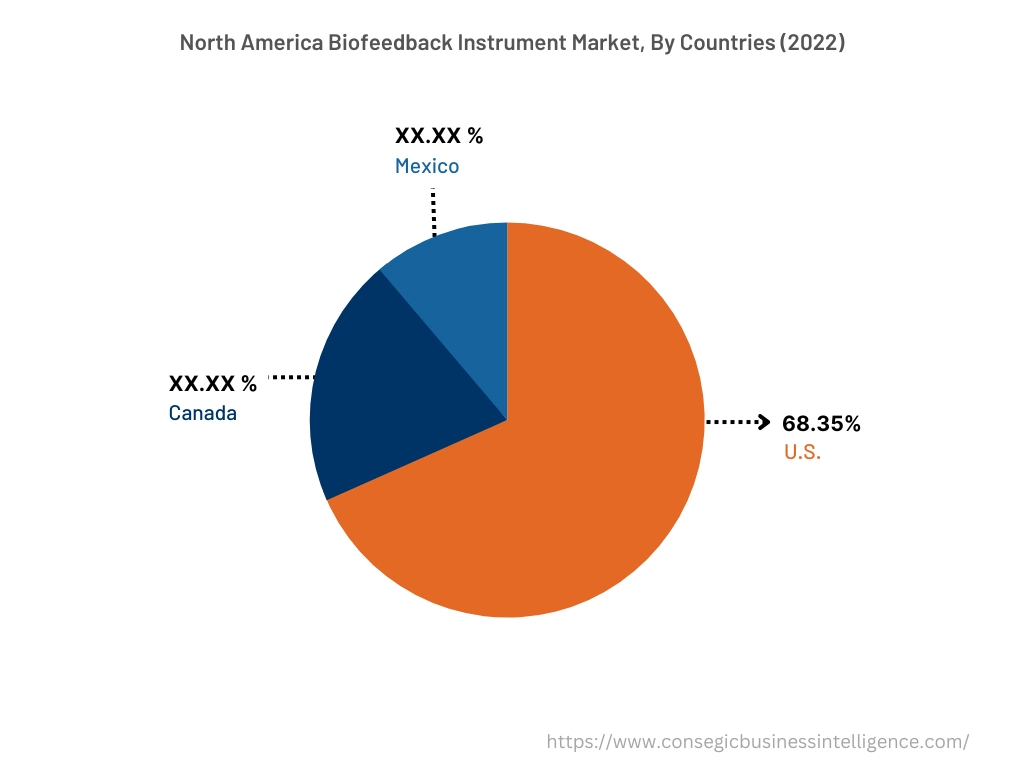
Top Key Players & Market Share Insights :
The biofeedback instrument market is highly competitive, with several large players and numerous small and mid-ranged enterprises. The competitive landscape of the market has been analyzed in the report, along with the detailed profiles of the major players operating in the industry. The companies functioning in biofeedback instrument industry have strong research and development capabilities and a strong presence in the market through their extensive product portfolios and distribution networks. The market is characterized by intense competition, with companies focusing on expanding their product offerings and increasing their market share through mergers, acquisitions, and partnerships. The key players in the market include-
- Thought Technology Ltd
- Mind Media USA Inc.
- Bio Feedback Resources International
- Neurocare Group AG
- Laborie Qxsubspace
- Quantum World Vision
- NeuroCare
Recent Industry Developments :
- In May 2021, Thought Technology is pleased to partner with TRUCHIRO who will take over distribution of the NeuroInfiniti physiological assessment and training system to the chiropractic market. Thus, the expansion of the Biofeedback Instrument portfolio through the partnership is fostering market expansion./li>
- In May 2023, Thought Tech launched the MyOnyx, an instrument for muscle rehabilitation in Japan in the summer of 2022, Thus, the introduction of a new range of biofeedback devices is benefiting the market proliferation.
Key Questions Answered in the Report
What was the market size of the biofeedback instrument industry in 2024? +
In 2024, the market size of biofeedback instrument was USD 193.69 million.
What will be the potential market valuation for the biofeedback instrument industry by 2032? +
In 2032, the market size of biofeedback instrument will be expected to reach USD 312.45 million.
What are the key factors driving the growth of the biofeedback instrument market? +
Increasing technological advancement in biofeedback instruments is driving the global Biofeedback Instrument market growth.
What is the dominating segment in the biofeedback instrument market by end-use? +
In 2024, the hospital segment accounted for the highest market share of 48.15% in the overall Biofeedback Instrument market.
Based on current market trends and future predictions, which geographical region is the dominating region in the Biofeedback Instrument market? +
North America accounted for the highest market share in the overall biofeedback instrument market.
